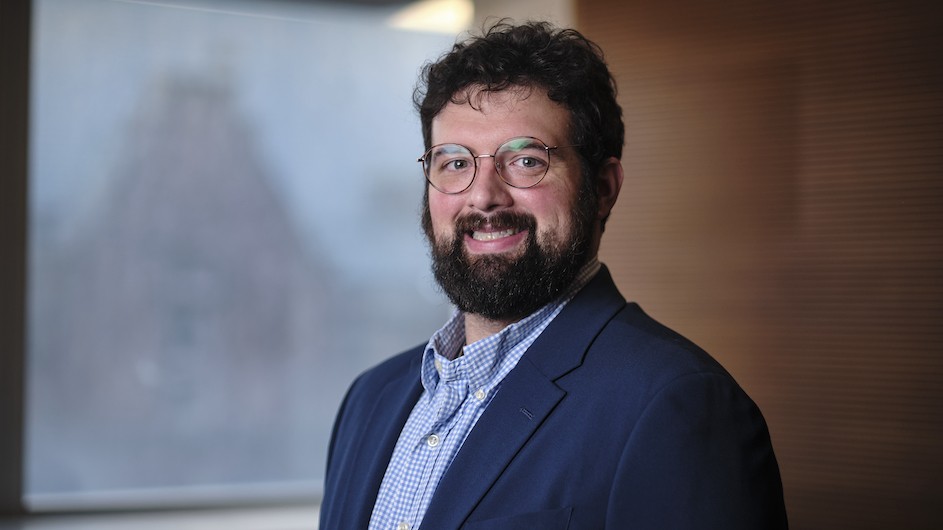A Program to Prepare Students for Graduate School Welcomes a New Director
Richard Hagen is the new full-time director of the Bridge to the PhD program in STEM.

Last month, as many students trickled away from Upper Manhattan to return home for the holidays, Richard Hagen arrived on campus.
Hagen is the incoming director of the Bridge to the Ph.D. Program in STEM, which brings an annual cohort of post-baccalaureates to Columbia for a two-year stint as paid research assistants. During their time at Columbia, participants in the program receive mentorship, pursue advanced coursework, and take part in workshops and other training opportunities that aim to prepare them for–and strengthen their applications to–full-time graduate school.
“I’ve spent my whole professional life working to help foster the science careers of students from nontraditional backgrounds,” Hagen said. “When I saw this job opening, I knew I had to apply.”
Marcel Agüeros, now an associate professor of astronomy, helped create the program in 2008, when he was a postdoctoral researcher. Psychology Professor Geraldine Downey, then the vice provost for diversity initiatives, had convened a number of people, including Agüeros’ longtime mentor, Astronomy Professor David Helfand, to help develop a post-baccalaureate program to foster diversity in STEM. Agüeros joined the working group and was eventually offered the job of inaugural director, and freedom to shape both the job and the initiative.
“At that time, there was a growing understanding that bridge experiences are key to opening up the sciences to a more diverse population of students. And I think that programs like ours are even more necessary today than 15 years ago, because students from underrepresented groups continue to face significant, systemic barriers to entering into our professions,” said Agüeros, who first came to Columbia as an undergraduate in 1992.
Since its founding, the program has sent its alumni to PhD programs at the University of Chicago, University of Utah, University of Wisconsin, Harvard, Johns Hopkins, Princeton, and, of course, Columbia. Of the roughly 100 people who have taken part in the program, around 90% have continued onto graduate school.
“Grad school is a tough environment. It requires a lot of students, and this program can be a great way to give them a sampling of what’s ahead while also strengthening their skills to make them really successful applicants and PhD researchers,” Hagen said.
After founding the program and running it for 10 years as the founding director, Agüeros handed the reins to the first designated, full-time director in 2017. Hagen, who started part-time with the program in October, is its third full-time director.
Before joining Columbia this month, Hagen was a chemistry professor and student advisor at Roberts Wesleyan University in Rochester, New York. He served on the school’s diversity and inclusion committee, the student retention and success committee, and the academic integrity committee. He also created a STEM night, an outreach program that brought students and faculty to schools around the region to teach them about science.
“A lot of my career and experience has really been focused on helping students who are academically gifted, but may have run into certain barriers in their career path,” he said.
Hagen said that he largely sees his new role as keeping the Bridge to STEM program running as-is, but over time he’d like to expand the program to collaborate with even more departments around the University than it already does.
Many of the students come out of the program with preparation and opportunities they would be unlikely to have had without it. Eden Shaveet, for example, is a current second-year scholar who was awarded a National Science Foundation (NSF) fellowship to fund three years of her forthcoming Ph.D. Noor Aftab, another member of the program, is currently working with faculty in the Astronomy Department to turn a survey of the night sky into a science-grade resource, usable by scientists.
Alumni of the program speak fondly of what it did for their career:
“The Bridge to the PhD in STEM program was a transformative experience for me and played a huge role in my development as a scientist,” said John Pamplin II, an assistant professor of epidemiology at Columbia’s Mailman School of Public Health, who took part in the program from 2010 to 2012. “The program gave me the opportunity to develop my scientific thinking in ways that transcend discipline, and that continue to play a role in my career today.”
Meanwhile, Hagen, who spent most of his life in Alabama before moving to Rochester, New York, for his previous job, is excited to be on campus, and in New York. Within 24 hours of arriving in the city, he and his daughter had already visited their local branch of the library, Harlem Library, just north of Marcus Garvey Park. Hagen browsed for mysteries, and checked out “The Plot,” by Jean Hanff Korelitz. His daughter looked for graphic novels.
“She’s almost as excited to be here as I am,” he said.